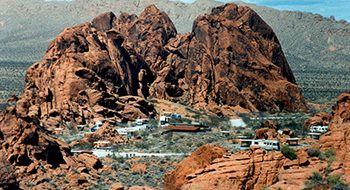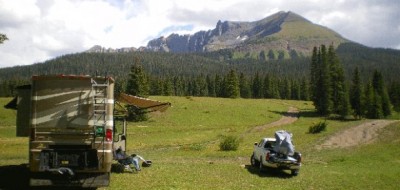By Bob Difley
Do you always choose a campground because of the availability of hook-ups? If so, you may be missing some of the pleasures of camping and the RV lifestyle experience; enjoyment of nature in the wild, wide open spaces, primitive areas, leaving the crowds behind, quiet, solitude, and no neighbors that are so close that you can hear them sneeze.
In dispersed camping areas with undesignated campsites or on open BLM or Forest Service land, you can get as close to or as far away from the action as you like. In Quartzite, for example, you will find clusters of campers around a single group fire pit as well as loners stretched out across the isolated reaches of the desert floor. I am not denigrating hook-up campgrounds. I frequently use destination campgrounds because of the amenities that are not available in government or primitive campgrounds, such as swimming pools, hot tubs, organized activities, laundry rooms, and a Wifi connection. But if you choose a campground because you feel that you cannot exist without hook-ups, the following tips and suggestions may help in encouraging you to try an occasional boondocking trip on some wide-open land or deep into a national forest. The easiest way to start dry camping is in an organized campground with water (though not available as a hook up at your site) and a dump station. Your continuous length of stay before the necessary battery recharging, dumping, and water tank filling is dependent on your RV’s capacities. The larger the capacities and the more conservative your use of them, the longer you will last. When fresh water and a dump station are available, it simply means driving to the water fill and dump station and taking care of business, then returning to your campsite. In remote camping areas you will have to drive further. With some clever deduction, you can conclude that the less water you use taking showers and washing dishes, the longer you will be able to extend your stay before having to dump or fill your water tank. This does not mean that you should avoid showering for a week and have to use all throwaway plates and utensils. Therefore, when available:
- Use campground showers and restroom facilities.
- Wash dishes in a dish tub and discard the dishwater into the campground gray water receptacle.
- Fill dishwashing tub from outside water supply.
- Drain gray water into a Tote Tank (from Camping World and other RV supply stores) which can be rolled away and dumped into dump station or toilet.
- Carry an extra hose(s). Maybe you can run them long enough to reach the campground water supply without having to move your rig.
- Carry a five-gallon Jerry jug of water that you can dump into your water tank if you inadvertently run low.
- When using RV supplied water for washing or showering, turn the water on to wet down, then turn off. Soap up, then turn water on to rinse off. You will save a lot of water—and pump running time–by not letting the water run.
The need to move temporarily from your campsite to dump and fill holds to “a chain is only as strong as its weakest link” axiom. If you still have half a tank of fresh water but your holding tanks are full, that puts a definite crimp in how long you can extend your stay, and the further away you camp from facilities, the more practical it becomes to practice conservation. You should NEVER stretch out your stay, however, by dumping your holding tanks—net even your gray water tank—on the ground. Always use an approved dump station. You’ll know that you have reached the epitome in the art of planning and conservation when your battery needs charging, your freshwater tank needs filling, and your holding tanks need to be emptied, all at precisely the same time. And if you are really good, it will be on the last day of your camping trip. Electricity Your 12-volt electrical system is sufficient for satisfying your power needs as long as you can get along without 120-volt current. If you have an inverter which converts 12-volt into 120-volt, you will still have to do without your air conditioner and microwave oven, which draw considerable amperes from your batteries. Leave your electric blanket and Mr. Coffee at home for the same reason. An extra blanket and a drip coffee maker work just as well. If you and your party observe a few basic electricity conservation rules, you will be able to get the most out of your trip.
- Use lights only when necessary and turn off lights that are not being used.
- Do not leave the porch light on.
- Use battery operated reading lights and flashlights.
- Do not leave a radio or TV operating if no one is listening or watching.
- Avoid using appliances that require high wattage to operate.
The amount of 12-volt electricity available to operate your systems limits your length of stay, or the time between recharging sessions. A single deep cycle 12-volt house battery will produce about 105 ampere-hours of electricity. By calculating the number of amps each of your electrical appliances draws multiplied by the hours in use you can make an educated guess at when you need to recharge by subtracting the ampere-hours used each day from the total available. Only about half of these amps (about 50) are available to run your electrical equipment. Take voltage readings at the battery terminals with a hand-held multi-meter and when the voltage drops to 11.5 volts, start your engine or run your charger/converter off your generator to recharge the battery. Installing a second house battery or switching to a pair of 6-volt golf cart batteries will increase the total number of available amps. Practice. Take notes. Keep a log. Soon you’ll be able to accurately judge how long you can go before your systems need attending. Try camping in new and more remote locations. Track the wildlife. Listen to the quiet. There’s a big world out there for boondocking and backroads exploring. For more RVing articles and tips take a look at my Healthy RV Lifestyle website, where you will also find my ebooks: BOONDOCKING: Finding the Perfect Campsite on America’s Public Lands (PDF or Kindle), 111 Ways to Get the Biggest Bang for your RV Lifestyle Buck (PDF or Kindle), and Snowbird Guide to Boondocking in the Southwestern Deserts, and my newest, The RV Lifestyle: Reflections of Life on the Road (Kindle reader version). NOTE: Use the Kindle version to read on your laptop, iPad and iPhone or any device that has the free Kindle reader app.

